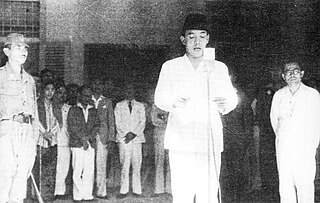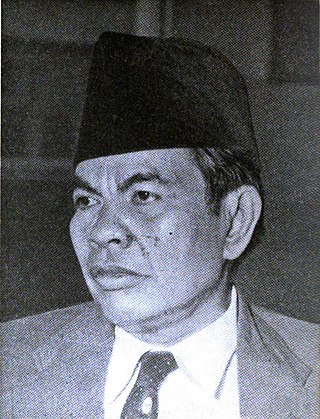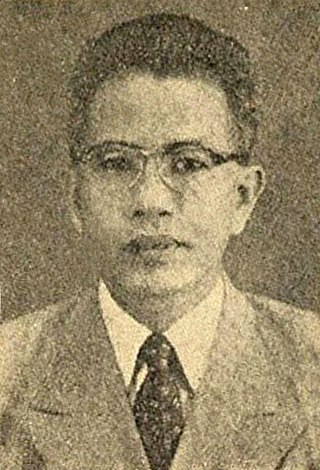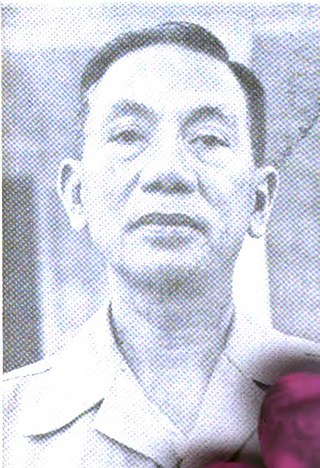
Hubertus Johannes "Huib" van Mook was a Dutch administrator in the East Indies. During the Indonesian National Revolution, he served as the Acting Governor-General of the Dutch East Indies from 1942 to 1948. Van Mook also had a son named Cornelius van Mook who studied marine engineering at the Massachusetts Institute of Technology. He also wrote about Java - and his work on Kota Gede is a good example of a colonial bureaucrat capable of examining and writing about local folklore.

The Proclamation of Indonesian Independence was read at 10:00 on Friday, 17 August 1945 in Jakarta. The declaration marked the start of the diplomatic and armed resistance of the Indonesian National Revolution, fighting against the forces of the Netherlands and pro-Dutch civilians, until the latter officially acknowledged Indonesia's independence in 1949. The document was signed by Sukarno and Mohammad Hatta, who were appointed president and vice-president respectively the following day.
Budi Utomo was an early native nationalist political society in the Dutch East Indies. The organization's founding in 1908 is considered instrumental to the beginning of the Indonesian National Awakening.

Dr. Gerungan Saul Samuel Jacob Ratulangi was a Minahasan teacher, journalist, politician, and national hero from North Sulawesi, Indonesia. He was part of the committee that ratified the Constitution of Indonesia and served as the first Governor of Sulawesi.

Mohammad Yamin was an Indonesian poet, politician and national hero who played a key role in the writing of the draft preamble to the 1945 constitution.

Indonesian Islamic Union Party was an Islamic political party in Indonesia before and after independence. In 1973 it was merged into the United Development Party.
The Association of Political Organisations of the Indonesian People was a federation of pre-war Indonesian political parties that was established to unite a range of organisations in the struggle for Indonesian independence.

The Indonesian Political Federation was an umbrella organization of various nationalist organizations in the Dutch East Indies which existed from 1939 to 1942. Founded to unite the nationalist movement, GAPI championed the creation of an Indonesian parliament in exchange for cooperation with the Dutch colonial government. The federation consisted of eight political parties. GAPI was dissolved was dissolved shortly after the invasion of the colony by the Empire of Japan in 1942.

The Volksraad was an advisory, and later semi-legislative institution for the Dutch East Indies, provided for by law in 1916 but only established with the actual installation of the Council in 1918. It was a hesitant and slow attempt at democratisation of the Dutch East Indies as part of the "ethical policy" adopted by the Dutch government. The power of the Volksraad was limited as it only had advisory powers. Although part of the council was elected, only a small proportion of the population had voting rights.

Mohammad Husni Thamrin was a pre-independence Indonesian political thinker and nationalist who after his death was named a National Hero.

Albertus Soegijapranata, SJ, better known by his birth name Soegija, was a Jesuit priest who became the Apostolic Vicar of Semarang and later its archbishop. He was the first native Indonesian bishop and known for his pro-nationalistic stance, often expressed as "100% Catholic 100% Indonesian".

The United States of Indonesia was a short-lived federal state to which the Netherlands formally transferred sovereignty of the Dutch East Indies on 27 December 1949 following the Dutch–Indonesian Round Table Conference. This transfer ended the four-year conflict between Indonesian nationalists and the Netherlands for control of Indonesia. It lasted less than a year, before being replaced by the unitary Republic of Indonesia.

Soetomo was an Indonesian physician and nationalist. He was the co-founder of Boedi Oetomo, the first native political society in the Dutch East Indies, and led the Great Indonesia Party (Parindra) from 1935 until his death. Soetomo was declared a national hero by President Sukarno in 1961.
Parindra was the name used by two Indonesian political parties.

Mohammad Tabrani Soerjowitjitro was an Indonesian journalist and politician. He originated from the island of Madura and received journalistic education in Europe. In his early journalistic career, Tabrani was a major proponent of the Indonesian language as a national language. Later on, he became the editor of the Pemandangan newspaper and promoted the independence of Indonesia through parliamentary means.
Ko Kwat Tiong Sia (1896–1970), known as Mr. Ko Kwat Tiong and later Mohamad Saleh, was a prominent Indonesian politician, lawyer, civil servant and university lecturer. He was elected to the Volksraad in 1935 as a representative of the Partai Tionghoa Indonesia, and – after Independence in 1945 – headed the Balai Harta Peninggalan in Central Java until retiring in 1960.

Soetardjo Kartohadikusumo was an Indonesian politician who served as the first Governor of West Java in 1945. A former member of the Volksraad, he was also renowned for the 1936 Soetardjo Petition.

The Council of the Indies was a body established in 1610 to advise and limit the powers of the governor-general of the Dutch East Indies. Following administrative reforms of 1836, the council was later renamed as the Council of the Dutch East Indies.
The Indonesian People's Movement, better known as Gerindo, was a left-wing and nationalist political party in the Dutch East Indies which existed from 1937 to 1942. It had modest goals and was largely cooperative to the colonial administration. More strongly anti-fascist than anti-colonialist, the party sought to support the colonial government in opposing fascism, especially Japanese fascism.
The Indonesian Islamic Party was an Islamic political party in the Dutch East Indies. Formed by dissenting members of the Indonesian Islamic Union Party (PSII) in 1938, the party was dissolved by the occupying Japanese in March 1942.














